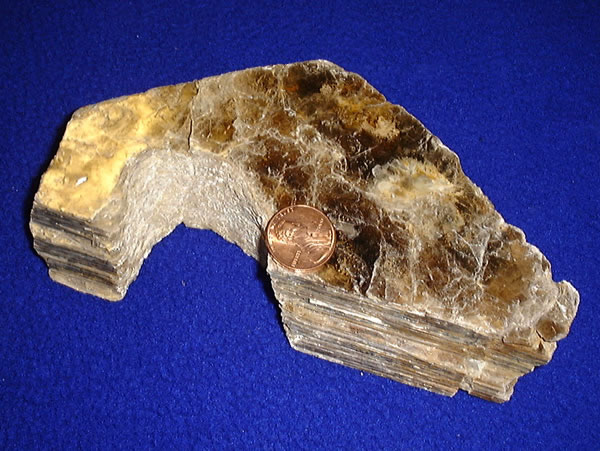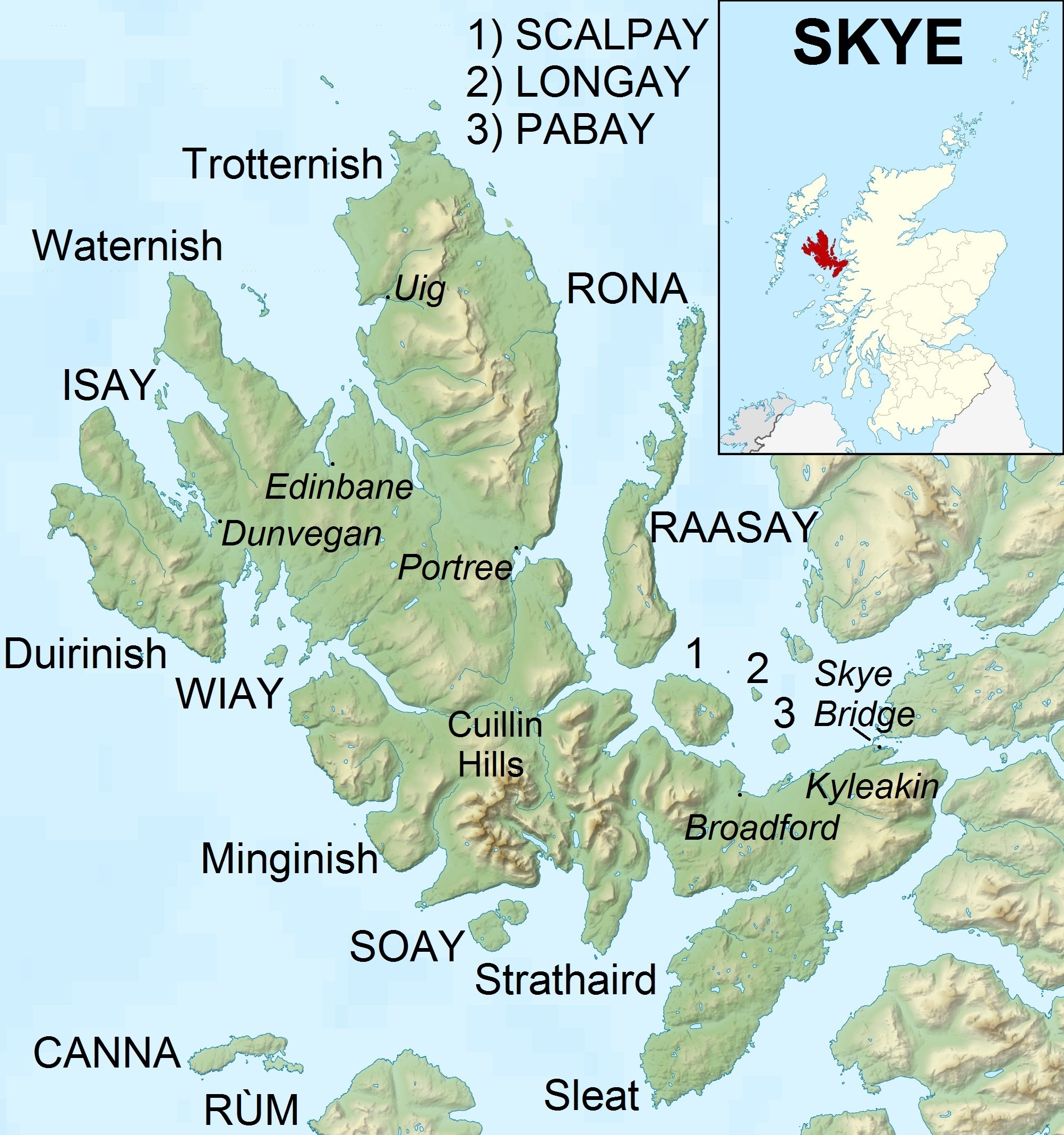|
Pabay Mòr
Pabay is a Scottish island just off the coast of Skye. The name Pabay is derived from an old Norse word meaning "priest's isle" and there are the remains of a 13th-century chapel. Geography Pabay is an island in the Inner Sound of Skye, lying north of Broadford. It lies south of Longay and east of the larger Scalpay. Like most others of the name, is a low grassy island. It is in size, diamond-shaped and predominantly flat. The highest point is above sea level, with cliffs on the North and East shores. The island is formed of fossil-containing limestone, with some micaceous shale, named Pabba Shale. It forms a flat plateau with cliffs on the North and East shores. The surrounding low reefs encroach on its shores and double the area at low water. The island gives its name to a group of Jurassic Sedimentary rocks which are seen across the Inner Hebredian area-Pabba Shales. These were laid down at the bottom of a muddy sea 190 million years ago. Much later (about 60 million ... [...More Info...] [...Related Items...] OR: [Wikipedia] [Google] [Baidu] |
Papar
The ''Papar'' (; from Latin , via Old Irish, meaning "father" or "pope") were Irish monks who took eremitic residence in parts of Iceland before that island's habitation by the Norsemen of Scandinavia. Their existence is attested by the early Icelandic sagas and recent archaeological findings. ''Papar'' in Iceland The first Norsemen began settling in Iceland in AD 874. The oldest Scandinavian source mentioning the existence of the ''Papar'', however, the '' Íslendingabók'' (Book of the Icelanders) by Icelandic chronicler Ari Þorgilsson, was written between 1122 and 1133, some time after the event. Ari writes of "Christian men", titled the ''Papar'' by the Norsemen, who departed the island because of their dislike of the 'heathen' Norse, pointing to the possibility of the ''Papar'' having arrived before the Norse. An earlier source that could possibly refer to the ''Papar'' is the work of Dicuil, an early 9th-century Irish monk and geographer, which included mention of the ... [...More Info...] [...Related Items...] OR: [Wikipedia] [Google] [Baidu] |
Gazetteer For Scotland
The ''Gazetteer for Scotland'' is a gazetteer covering the geography, history and people of Scotland. It was conceived in 1995 by Bruce Gittings of the University of Edinburgh and David Munro of the Royal Scottish Geographical Society, and contains 25,870 entries as of July 2019. It claims to be "the largest dedicated Scottish resource created for the web". The Gazetteer for Scotland provides a carefully researched and editorially validated resource widely used by students, researchers, tourists and family historians with interests in Scotland. Following on from a strong Scottish tradition of geographical publishing, the ''Gazetteer for Scotland'' is the first comprehensive gazetteer to be produced for the country since Francis Groome's '' Ordnance Gazetteer of Scotland'' (1882–1886) (the text of which is incorporated into relevant entries). The aim is not to produce a travel guide, of which there are many, but to write a substantive and thoroughly edited description of ... [...More Info...] [...Related Items...] OR: [Wikipedia] [Google] [Baidu] |
Uninhabited Islands Of Highland (council Area)
The list of uninhabited regions includes a number of places around the globe. The list changes year over year as human beings migrate into formerly uninhabited regions, or migrate out of formerly inhabited regions. Definitions The exact definition of what makes a place "uninhabited" is not simple. Nomadic hunter-gather and pastoral societies live in extremely low population densities and range across large territories where they camp, rather than staying in any one place year-round. During the height of settler colonialism many European governments declared huge areas of the New World and Australia to be ''Terra nullius'' (land belonging to no one), but this was done to create a legal pretext to annex them to European empires; these lands were not, and are not uninhabited. While some communities are still nomadic, there are many remote and isolated communities in the less populated parts of the world that are separated from each other by hundreds or thousands kilometres o ... [...More Info...] [...Related Items...] OR: [Wikipedia] [Google] [Baidu] |
Martin Martin
Martin Martin (Scottish Gaelic: Màrtainn MacGilleMhàrtainn) (–9 October 1718) was a Scotland, Scottish writer best known for his work ''A Description of the Western Islands of Scotland (Martin), A Description of the Western Islands of Scotland'' (1703; second edition 1716). This book is particularly noted for its information on the St. Kilda, Scotland, St Kilda archipelago. Martin's description of St Kilda, which he visited in 1697, had also been published some years earlier as ''A Late Voyage to St Kilda'' (1698). Life Martin was a native of Bealach, near Duntulm on Isle of Skye, Skye. He was born around 1660, a son of Donald Martin, who served with the MacDonalds of Sleat under James Graham, 1st Marquess of Montrose, and his wife Màiri, who was a niece of Sir Donald Gorme Og Macdonald, 1st Baronet. He is thought to have had at least two brothers,Charles W. J. Withers, Withers, Charles W.J. (1999), Introduction to ''A Description of the Western Islands of Scotland circa 1695 ... [...More Info...] [...Related Items...] OR: [Wikipedia] [Google] [Baidu] |
Clan Mackinnon
Clan MacKinnon ( ) is a Scottish Highlands, Highland Scottish clan from the islands of Isle of Mull, Mull and Skye, in the Inner Hebrides. Popular tradition gives the clan a Dal Riada, Dalriadic Gaelic origin. The 19th-century historian W. F. Skene named the clan as one of the seven clans of Siol Alpin, who according to Skene could all trace their ancestry back to Alpín mac Echdach, Alpin, father of Cináed mac Ailpín.Skene, pp. 258–260. Popular tradition has been until recently to consider Cináed mac Ailpín the first King of Scots and a Gael, however recent research speculates Cináed was a Pictish king and possibly even a Pict himself.Johnston, Ian"First king of the Scots? Actually he was a Pict". ''The Scotsman''. 2 October 2004. Retrieved on 16 November 2007 Sir Iain Moncreiffe of that Ilk speculated that Clan MacKinnon belonged to the kindred of Saint Columba, noting the MacKinnon Coat of Arms, arms bore the hand of the saint holding the Cross, and the several Mackinno ... [...More Info...] [...Related Items...] OR: [Wikipedia] [Google] [Baidu] |
Shale
Shale is a fine-grained, clastic sedimentary rock formed from mud that is a mix of flakes of Clay mineral, clay minerals (hydrous aluminium phyllosilicates, e.g., Kaolinite, kaolin, aluminium, Al2Silicon, Si2Oxygen, O5(hydroxide, OH)4) and tiny fragments (silt-sized particles) of other minerals, especially quartz and calcite.Blatt, Harvey and Robert J. Tracy (1996) ''Petrology: Igneous, Sedimentary and Metamorphic'', 2nd ed., Freeman, pp. 281–292 Shale is characterized by its tendency to split into thin layers (Lamination (geology), laminae) less than one centimeter in thickness. This property is called ''Fissility (geology), fissility''. Shale is the most common sedimentary rock. The term ''shale'' is sometimes applied more broadly, as essentially a synonym for mudrock, rather than in the narrower sense of clay-rich fissile mudrock. Texture Shale typically exhibits varying degrees of fissility. Because of the parallel orientation of clay mineral flakes in shale, it breaks in ... [...More Info...] [...Related Items...] OR: [Wikipedia] [Google] [Baidu] |
Mica
Micas ( ) are a group of silicate minerals whose outstanding physical characteristic is that individual mica crystals can easily be split into fragile elastic plates. This characteristic is described as ''perfect basal cleavage''. Mica is common in igneous and metamorphic rock and is occasionally found as small flakes in sedimentary rock. It is particularly prominent in many granites, pegmatites, and schists, and "books" (large individual crystals) of mica several feet across have been found in some pegmatites. Micas are used in products such as drywalls, paints, and fillers, especially in parts for automobiles, roofing, and in electronics. The mineral is used in cosmetics and food to add "shimmer" or "frost". Properties and structure The mica group comprises 37 phyllosilicate minerals. All crystallize in the monoclinic system, with a tendency towards pseudohexagonal crystals, and are similar in structure but vary in chemical composition. Micas are translucent to opa ... [...More Info...] [...Related Items...] OR: [Wikipedia] [Google] [Baidu] |
Limestone
Limestone is a type of carbonate rock, carbonate sedimentary rock which is the main source of the material Lime (material), lime. It is composed mostly of the minerals calcite and aragonite, which are different Polymorphism (materials science), crystal forms of calcium carbonate . Limestone forms when these minerals Precipitation (chemistry), precipitate out of water containing dissolved calcium. This can take place through both biological and nonbiological processes, though biological processes, such as the accumulation of corals and shells in the sea, have likely been more important for the last 540 million years. Limestone often contains fossils which provide scientists with information on ancient environments and on the evolution of life. About 20% to 25% of sedimentary rock is carbonate rock, and most of this is limestone. The remaining carbonate rock is mostly Dolomite (rock), dolomite, a closely related rock, which contains a high percentage of the mineral Dolomite (mine ... [...More Info...] [...Related Items...] OR: [Wikipedia] [Google] [Baidu] |
Scalpay, Inner Hebrides
Scalpay (; ) is an inhabited island in the Inner Hebrides of Scotland which has a population of 4. Geology The bedrock of Scalpay is largely the Neoproterozoic age sandstone and conglomerates of the Sithean Glac an Ime Member of the Applecross Formation and in the west, the Mullach nan Carn members of the Diabaig Formation, a unit of the Torridon Group, or informally the Torridonian sandstone. Outcrops of hornfelsed basalt of the Palaeocene age Skye Lava Group and the Palaeogene age Scalpay granite are found in the south and west of Scalpay. The Scalpay Sandstone and Pabay Shale formations found in the southeast of the island around Scalpay House are assigned to the Lias Group. The Staffin Shale and Staffin Bay formations are of late Jurassic age and found east of Rubha Aosail Sligneach at Caolas Scalpay. Quaternary deposits are represented by peat in the north, present day marine deposits and raised marine deposits along the southwestern shore and a restricted area of gl ... [...More Info...] [...Related Items...] OR: [Wikipedia] [Google] [Baidu] |
Isle Of Skye
The Isle of Skye, or simply Skye, is the largest and northernmost of the major islands in the Inner Hebrides of Scotland. The island's peninsulas radiate from a mountainous hub dominated by the Cuillin, the rocky slopes of which provide some of the most dramatic mountain scenery in the country.#Slesser70, Slesser (1981) p. 19. Although has been suggested to describe a winged shape, no definitive agreement exists as to the name's origin."Gaelic Culture" . VisitScotland. Retrieved 5 January 2013. The island has been occupied since the Mesolithic period, and over its history has been occupied at various times by Celtic tribes including the Picts and the Gaels, Scandinavian Vikings, and most notably the powerful integrated Norse-Gaels clans of Clan MacLeod, MacLeod and Clan Donald, MacDonald. The island was considered to be under ... [...More Info...] [...Related Items...] OR: [Wikipedia] [Google] [Baidu] |
Longay
Longay () is a small uninhabited Scottish island in the Inner Sound just off the coast of the Isle of Skye, north of Pabay and east of Scalpay. In 1971, the Caledonian MacBrayne Caledonian MacBrayne (), in short form CalMac, is the trade name of CalMac Ferries Ltd, the major operator of passenger and vehicle ferries to the west coast of Scotland, serving ports on the mainland and 22 of the major islands. It is a subsid ... mailboat ''Loch Seaforth'' ran aground on the island, sustaining only minimal damage. References Uninhabited islands of Highland (council area) {{Highland-geo-stub ... [...More Info...] [...Related Items...] OR: [Wikipedia] [Google] [Baidu] |







